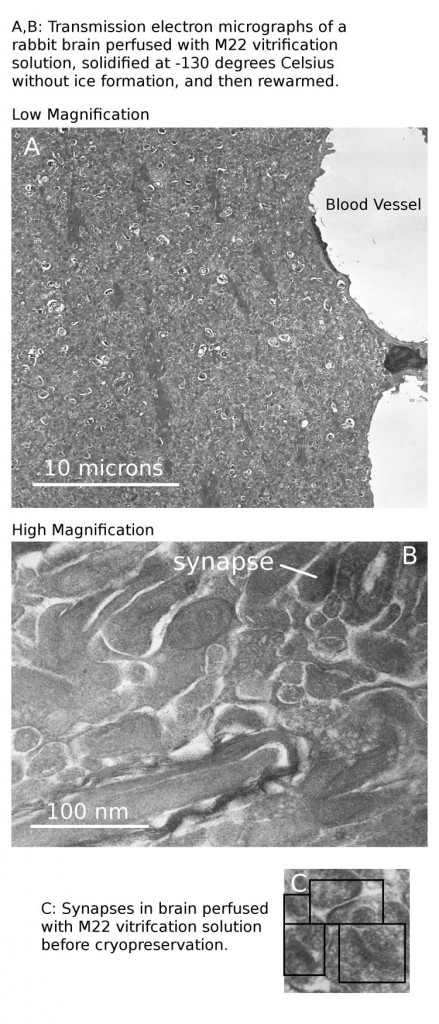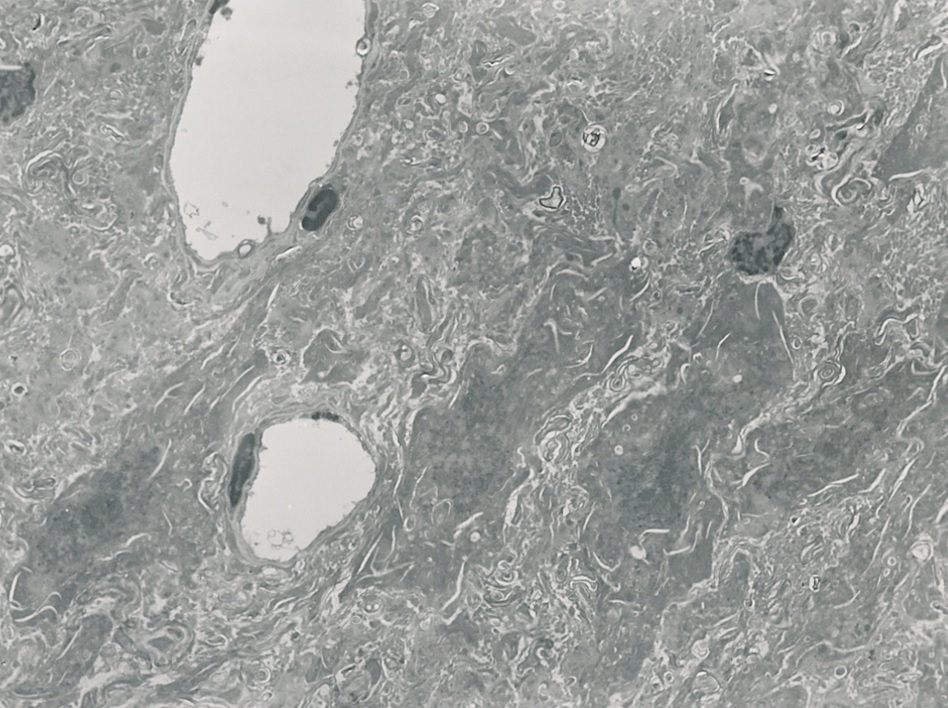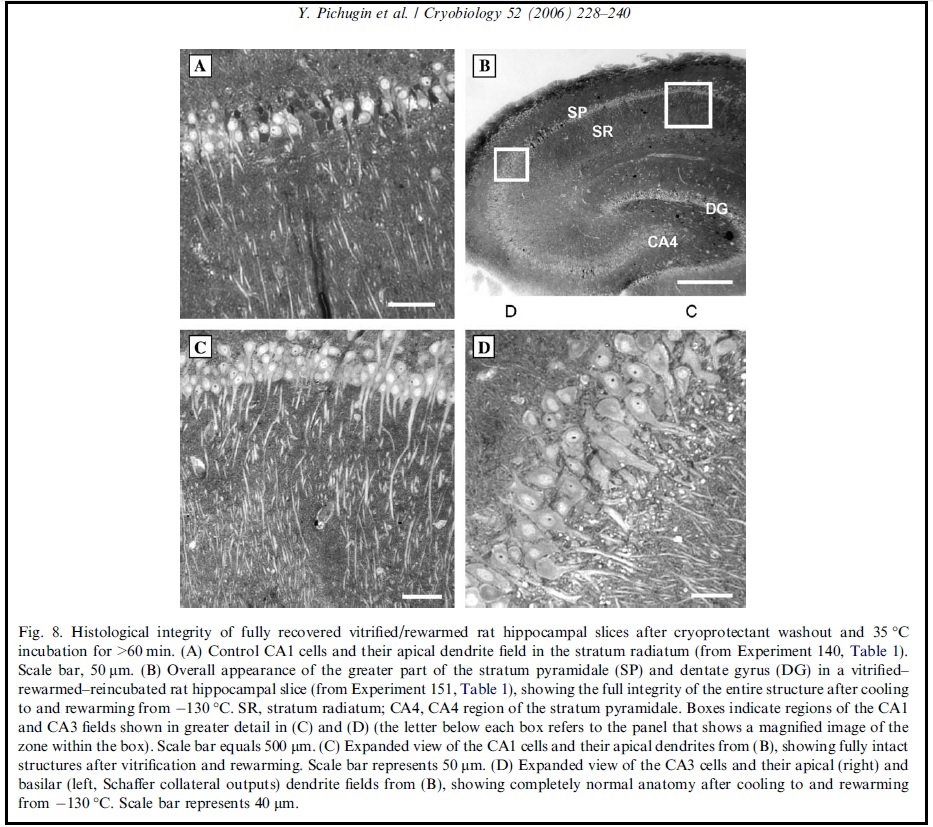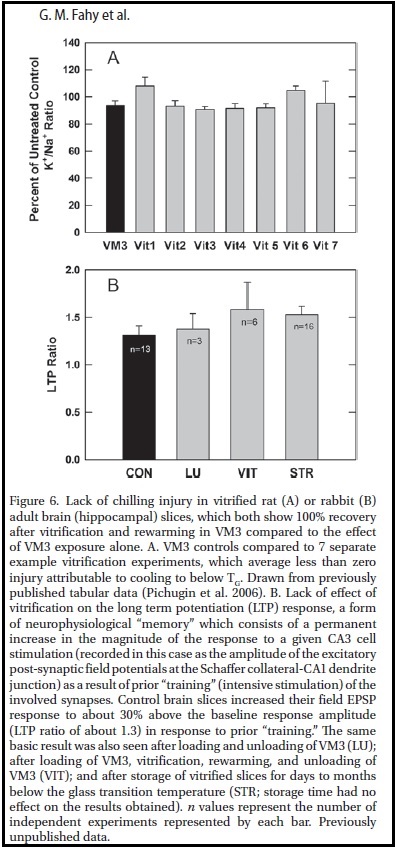Overview of 21st Century Medicine’s Cryopreservation for Viability Research
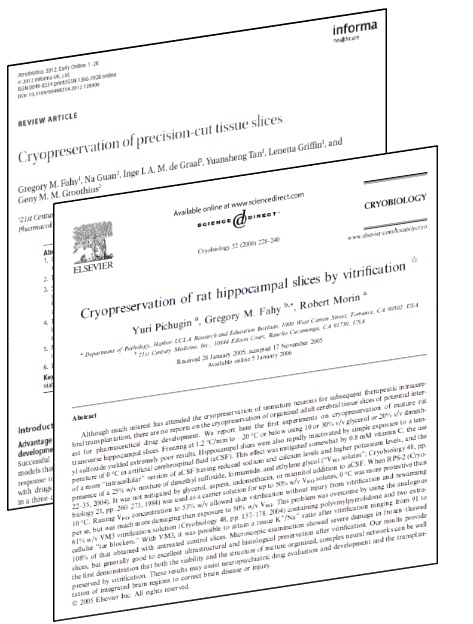 21st Century Medicine (21CM) is a cryobiology research company whose core mission is to develop a cryopreservation protocol sufficiently benign that whole, donated human organs could be vitrified (stored below -130 degrees Celsius without ice formation) and rewarmed when needed for transplantation -an incredibly ambitious goal that has so far eluded medical researchers. 21CM’s scientists are the original pioneers of whole organ vitrification and have been diligently working on the technique for decades. A significant milestone of their progress toward that goal is their demonstration work on rabbit kidneys. Two of their most relevant publications are “Cryopreservation of organs by vitrification: perspectives and recent advances” (Fahy, Wowk, Wu, Phan, Rasch, Chang & Zendejas 2004) and “Physical and biological aspects of renal vitrification” (Fahy, Wowk, Pagotan, Chang, Phan, Thomson & Phan 2009). These papers are a fantastic resource for anyone interested in just how difficult it is to cryopreserve large organs (and by extension whole animals) for long-term storage with the intent on later recovery of biological function. In short, it is incredibly difficult but progress is slowly being made.
21st Century Medicine (21CM) is a cryobiology research company whose core mission is to develop a cryopreservation protocol sufficiently benign that whole, donated human organs could be vitrified (stored below -130 degrees Celsius without ice formation) and rewarmed when needed for transplantation -an incredibly ambitious goal that has so far eluded medical researchers. 21CM’s scientists are the original pioneers of whole organ vitrification and have been diligently working on the technique for decades. A significant milestone of their progress toward that goal is their demonstration work on rabbit kidneys. Two of their most relevant publications are “Cryopreservation of organs by vitrification: perspectives and recent advances” (Fahy, Wowk, Wu, Phan, Rasch, Chang & Zendejas 2004) and “Physical and biological aspects of renal vitrification” (Fahy, Wowk, Pagotan, Chang, Phan, Thomson & Phan 2009). These papers are a fantastic resource for anyone interested in just how difficult it is to cryopreserve large organs (and by extension whole animals) for long-term storage with the intent on later recovery of biological function. In short, it is incredibly difficult but progress is slowly being made.
The state-of-the-art whole organ vitrification techniques developed by 21CM are the basis of the human cryopreservation protocols used by some cryonics companies (e.g. Alcor). This is made clear in Alcor’s 2004 publication in the New York Academy of Sciences “The Arrest of Biological Time as a Bridge to Engineered Negligible Senescence” (Lemler, Harris, Platt & Huffman 2004).
21CM has been an official competitor in our Brain Preservation Prize competition since 2012. They actually have two separate preservation techniques competing for our prize: the “straight” cryopreservation\cryonics technique described on this page, and a radically new technique called “Aldehyde Stabilized Cryopreservation” (ASC), described on a separate page ,which they developed to overcome the “tissue shrinkage” issues described on this page and to optimize ultrastructure preservation at the expense of viability.
In 21CM’s “straight” cryopreservation\cryonics technique surgery is performed on an anesthetized rabbit to gain access to the blood vessels supplying the brain, and a cocktail of cryoprotectant agents (CPA) are perfused into the brain in increasing concentrations as the brain’s temperature is simultaneously being lowered. 21CM has not yet published an article describing the protocol they use for cryopreserving brains but the protocol and CPA used are similar to the ones 21CM uses for cryopreserving rabbit kidneys and is similar to the protocols used by Alcor for human patients.
How well does 21CM’s “straight” cryopreservation technique preserve the brain? Is the brain preserved well enough to meet the requirements of the Brain Preservation Prize? Unfortunately the answers to these questions are a bit complicated. 21CM’s cryopreservation protocol is designed to prevent all ice crystal formation in the brain even as the brain’s temperature is slowly lowered to below -130 degrees C. To accomplish this they must remove most of the water from the brain (both inside and outside cells) and replace it with a highly concentrated CPA solution called M22. They claim that for technical reasons (having to do with, among other things, the blood brain barrier and increased viscosity of CPA at low temperatures) the ramp up in perfused CPA concentration cannot be delivered in a way that avoids osmotic shrinkage of the brain. In fact the protocol calls for the brain to be shrunken in size by approximately 50%! And 21CM has so far been unable to reverse this shrinkage effect prior to preparing and staining brain slices for electron microscopic evaluation. As a result it has been impossible so far to adequately assess how well the connectome is preserved. 21CM believes that the connectome is preserved but in a shrunken, compressed form. We at the BPF must remain skeptical since even if such dramatic shrinkage did not itself cause damage, it could certainly be hiding damage coming from other parts of the process.
Here is an excerpt of an email sent to the BPF from the researchers at 21CM clearly outlining these issues:
“A typical M22 brain shrinks from a normal 10 grams to typically 5 grams or less due to the osmotic effect of M22. The brain shrinks pretty much isotropically, so what you get at the end looks largely like a small version of what you started with. To put this in perspective, the solids content of the brain may be in the vicinity of 20%, the rest being water. The solids, of course, are still there after shrinkage, which means the water content declines from perhaps 80% to perhaps 25-30% or, expressed differently, the volume within cells, axons, and dendrites, probably declines by around 70%. This means all proteins and the like are concentrated by about three-fold. As a result of this, using normal staining techniques, the cytoplasm, axoplasm, etc. tends to look black. This makes synapses, which are recognized by their blackness, basically, hard to see… It may also make it hard to distinguish between one axon and another if they are closely approximated, since the cytoplasm is so dark, which would pose a challenge for following all the processes (and hence their connections). “
These issues regarding the shrinkage of the brain during today’s “normal cryonics” procedures are also articulated on Alcor’s website:
http://www.alcor.org/Library/html/newtechnology.html
Here are example images sent to us by 21CM showing this shrinkage. Images we have taken of their samples look similar.
The above imaging results of whole cryopreserved brains were disappointing to us at the BPF since we had hoped to use today’s 3D electron microscopy (EM) techniques to prove cryonics preserves the brain’s connectome. The ‘mainstream’ neuroscience colleagues that I have shared such images with have expressed similar disappointment. When compared with the beautifully detailed images of synaptic circuit ultrastructure in neuroscience textbooks, these images of whole cryopreserved brains are almost unrecognizable due to the severe osmotic shrinkage. However, I want to stress that 21CM has not given up on curing this problem and they continue to work (with limited resources) toward a protocol that can either eliminate such osmotic shrinkage or at least reverse it prior to EM image evaluation.
Brain slice work:
In stark contrast to the above whole brain results, similar cryoprotectant formulas and protocols applied to half millimeter thick slices of living brain have shown good ultrastructure preservation and amazingly good recovery of function after rewarming from weeks of -130 degrees C storage. 21CM has published two papers on such ‘brain slice vitrification’ research:
“Cryopreservation of rat hippocampal slices by vitrification” in the Journal of Cryobiology (Pichugin, Fahy & Morin 2006)
“Cryopreservation of precision-cut tissue slices” in the journal Xenobiotica (Fahy, Guan, de Graaf, Tan, Griffin & Groothuis 2013)
Here is a figure from their 2006 paper showing a half millimeter thick hippocampal slice which has been immersed in CPA, lowered to -130 degrees C, vitrified solid and then rewarmed. Following this the CPA was washed out and the tissue was assessed for structural integrity and cellular viability:
And here is a figure from their 2013 paper showing recovery of LTP memory electrophysiology for half millimeter thick hippocampal slices that had previously been vitrified and stored for weeks:
These are truly amazing results showing that cryopreservation of brain tissue with significant recovery of functioning is possible. With recovery-of-function results like this, one might expect that demonstrating whole brain ultrastructure preservation for our Brain Preservation Prize would be trivial. Unfortunately it is much easier to get cryoprotectant solutions into and out of half millimeter slices than whole brains.
In summary, 21CM’s “straight” cryopreservation\cryonics technique for whole brain preservation eliminates ice crystal formation but does so at the cost of severely shrinking the brain through osmotic dehydration. If this shrinkage effect could be avoided or reversed in some way then one could expect similarly good structural preservation and recovery of function as has been shown in their half millimeter thick brain slice work.

